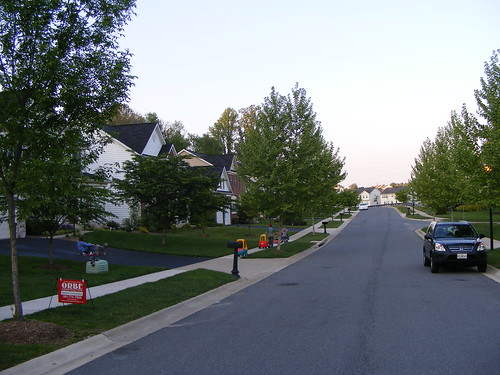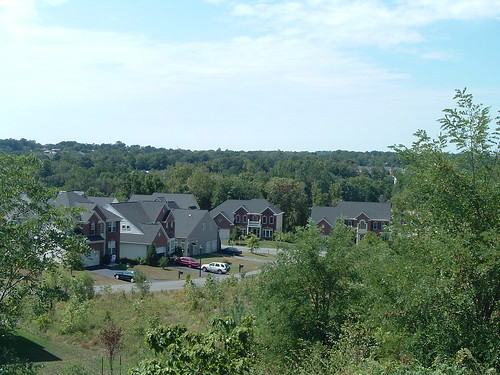 Many of my neighbors have moved to Olney, but is it because East County isn't hospitable to middle-class families.
Many of my neighbors have moved to Olney, but is it because East County isn't hospitable to middle-class families.I have a lot of respect for Stuart Rochester. He is the public face of East County, someone who’s lived here for a quarter-century and has given a lot of his time and energy to various forms of civic activism. What I don’t respect is his insistence that this community is under siege by poor people, or that this area is “neglected” by the County.
People like Rochester who can become involved are not neglected; in fact, they're heard loud and clear by the powers-that-be. The people who are neglected are the ones who don’t have the time or resources to get active. Stuart Rochester does not represent them. His main talking point is that the 1981 Fairland Master Plan - which he worked to rewrite as chairman of its Advisory Committee in 1997 - ruined the east side by allowing the development of apartments and affordable housing in places like Briggs Chaney.
In last week’s Gazette he's talking about the proposed Fairland Park development in Burtonsville, which will include 319 "move-up" homes and 46 townhouses, all affordable. He says the Master Plan “transformed what had been a stable community of schools and neighborhoods into an area marked and much diminished by limited housing options, middle-class flight and one of the highest school transiency rates in the county.”
 Homes in Cross Creek Club, a recently-completed golf-course community in Calverton.
Homes in Cross Creek Club, a recently-completed golf-course community in Calverton.My neighbors sold their house and are moving to Olney, to a house on a lot that are probably twice as big as what they have now. They’ve lived here for seventeen years and raised a family here. When they move, they’ll have one kid at home. Most of the kids I grew up with had parents who lived in D.C. or in Downtown Silver Spring before they moved here, and now they’re all talking about moving to Rockville or Olney or Columbia.
But my neighborhood isn’t decaying, and we have a number of County-subsidized affordable units. There's a very involved homeowners’ association and homes than sell for upwards of a half-million dollars even after the bubble has popped. I am pretty sure there are fifteen people living in the house next door to me – a sprawling, multi-generational Sudanese family who couldn’t care less about HOA regulations saying you can’t service cars in your garage – but when most of our neighbors move out, someone who looks like them takes their place.
I don’t think “middle-class” people have any difficulty finding or affording a place to live in this area. My mother jokes that our neighbors move to Olney or Rockville to “live with the white people.” Maybe that’s their intention – and we’ve had neighbors who are white, black, and everything in between. They have two choices: either get up and fight, like Stuart Rochester does, for a community that has the same “quality of life” (whatever that means to you) as an Olney or Rockville, or vote with their feet and leave.
 Apartments in Briggs Chaney.
Apartments in Briggs Chaney.There are a lot of people who don’t have either of those choices. Maybe County-subsidized housing or an apartment is the only option they have. Maybe these schools are the only ones they can send their kids to, because they can’t afford private school and they figure the worst school in Montgomery County beats the pants off any school in Prince George’s or the District, right? These people do not come to Planning Board meetings; they don’t have time to write letters to the Gazette; they don’t have time to sit on advisory committees. And, as miserable as those apartments off Briggs Chaney Road may look to some, I don’t think they’d call it a “fiasco.” They might call it “home.”
There’s absolutely nothing wrong with building “move-up” housing at Fairland Park. Rochester argues that the project “promises to help balance the housing and demographic envelope, help stabilize schools plagued by high transiency and contribute to keeping the middle class, white and minority, from leaving Fairland for Howard County or [Interstate] 270.” But I don’t think that this is the solution to the issues East County faces, nor is pointing fingers at affordable housing – the units we’ve built and the units we have yet to build. A house is not a school or a neighborhood or even a status symbol, because if it was, my neighbors would’ve just gone down the street to Cross Creek Club and bought a big, new house on the golf course.
They’re moving to Olney because it is Olney. It’s a matter of image and reputation: Olney is supposed to be a good place to raise a family. The longer that East County is represented by someone who says that East County has been devastated, the longer that we’ll continue to see families pass us over for seemingly greener pastures. I mean, if Stuart Rochester is so concerned about transiency in the schools, why don't I see him at the School Board instead of the Planning Board?

3 comments:
One of the reasons people move to Olney is because both the majority of Olney and the majority of its infrastructure are 30 years old, or less than 30 years old.
Another thing about Olney: they have very little public transportation, and there's a period of time between when significant public transportation/mass-transit reaches a place, and when the community adapts to it, when all of the riff-raff sees the newly-accessible destination as fresh fields for fun and frolic.
Let's just say that Aspen Hill's problems -- especially those in South Aspen Hill -- didn't really come into being until all of Ride-On routes were added.
A lot of folks moved out of here mostly because of who they saw getting on and off of buses in front of their houses. I personally think that the best thing that could happen to improve Aspen Hill right about now would be eliminating the Ride-On 48 route. The route of the old Metrobus tended to serve mostly professionals commuting to Federal and comparable jobs in the inner cores, the route of the Ride-On 48 tends mostly to serve hourly workers commuting to the Rockville Industrial Park, and also it serves a lot of seriously messed-up people going to and from their low-rent or disability provider services such as Manna's monthly handouts, etc., or people connecting to get to the addiction/rehab services concentrated at 751 Twinbrook Parkway.
But that's how the Developers and their pals on the County Council force the building of new Sprawl... let certain neighborhoods -- many of them in District 4 -- just go straight to hell, and everyone who can afford it will demand a new house in Olney. Their flight -- which could be "white flight" but which really is mostly middle-class flight -- is from increasing poverty and slumburbianization, to areas with well-maintained or fairly "young" infrastructure, and especially they're headed for places where the middle-class culture is thriving and even growing, and where the culture of poverty and hopelessness has barely reached.
How blessed is life in Olney?
A few weeks ago I was out doing some public-service community stuff in close-in Olney, and some l'il gangsta fool type drives by with the thug face on and all of the stalwarts of the PTA actually had the nerve to yell "slow down, okay" at him. Here in Aspen Hill we grown-ups just shake our heads and wish we could afford to move to Olney where those gangsta fools aren't the clear majority and just waiting for us to die, and as obviously getting tired of waiting.
Other people here in Aspen Hill who aren't moving? Orthodox Jews who are not going to move more than a mile from their place of worship. Then again, maybe they'll get sick of it too, and build a couple of nice synagogues farther out, and move. And there will go the last of our middle class here, unless you want to count the folks who are about to move from here to Leisure World.
I wonder, does Stuart Rochester complain about "demographic imbalance" when there are too many white people in one place? Or is imbalance only caused by the presence of too many people of color?
He says communities work when there is socio-economic and demographic balance.
But what does that balance look like? Half poor and half people of color? Is that the balance he's going for? Because if it is, we need many more people of color to achieve the balance that Stuart's seeking.
So let's push to get a whole lot more minorities into the county, so Stuart can have some "balance."
I think montgomery county is eventually going to look more like a suburban version of dc, the west and I 270 corridor will continue to be affluent and the economic engine of the county like NW DC and the east part of county will continue to decay and grow more violent and low income and will look like more like a suburban version of NE DC.
Post a Comment